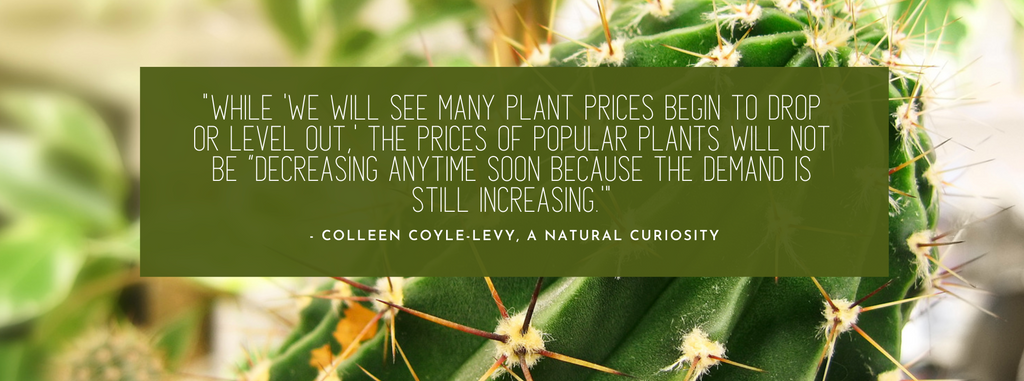
According to the article “So You Can't Stop Killing Your Houseplants,” houseplant purchases have surged in the last couple years. This is because “Mid-century Modernism, Maximalism, and overall homier trends have found their way back into popular consciousness.” This has resulted in a “renewed focus on the ability of nature to support mental health." This renewed focus “may also have driven the rise in plant popularity.” While interest in houseplants had been on the rise before the pandemic, the forced stay-at-home measures of COVID-19 solidified the trend.
This increasing obsession with houseplants and their air quality-boosting, emotional health supporting qualities has resulted in higher prices and supply shortages. As such, a number of would-be plant parents have been unable to purchase those they were most excited about. Several questions remain for the future of the houseplant industry. Will the interest continue to grow? Will prices continue to rise? Will supply catch up with demand? Follow below to learn the answers to these questions, as well as a bit more about the supply and demand for houseplants during COVID-19.
Surging Demand for Houseplants during COVID-19 - It's Based on Emotional Connection!

Houseplant demand has surged across continents - not just throughout the United States - as more people are kept at home due to the COVID-19 pandemic. Citizens of many nations across the world have begun to reassess the importance of nature for mental and emotional health.
The pandemic has offered an interesting opportunity in this sense. Our access to human contact has been curtailed while our access to nature has been expanded. Emma Reid explains the accelerating trend in her article “Pandemic grows popularity of indoor plants” for media outlet Bundaberg Now. Reid writes that the last few months have seen a rise in new home gardeners. She notes that “COVID-19 restrictions have afforded many people more time to put on those gardening gloves and test out their green thumb.”
Our continuing lack of exposure to other people in meaningful ways has resulted in new responsibilities for our houseplants. Gideon Lasco explains this phenomenon in his article “How COVID-19 Is Changing People’s Relationships With Houseplants” for Sapiens.org. Lasco writes that the pandemic “has spurred a ‘botanic boom’ all over the world." This boom has led people everywhere, from "Singapore to London to buy, collect, and nurture plants in their condominium units and apartments.” Lasco notes that one way our relationships with plants has become more significant to us is through our choice to name them. According to Hilton Carter - a gardening expert interviewed by Lasco - “humans only give names to things that matter to them.” We name our houseplants in order to bond with them, Carter explains. It is our way of encouraging ourselves to “care for it much better” than we otherwise might have.
According to Carter and Lasco, humans have formed emotional attachments with plants for thousands of years. As such, this trend - while somewhat new to our generation - is not new to the human species. This search for connection might explain why our interest in houseplants has peaked during the pandemic. Lasco writes that “even plant parents who do not name their plants...ascribe emotional states to them” based on the health of the plant. For instance, happiness for vibrant, straight-standing leaves and sadness for drooping, yellowing leaves. Through these attributions, we afford plants status as “individuals with distinct identities and personalities.” All in all, Lasco writes, our indoor houseplants encourage us to participate “in symbiotic relationships." These relationships are simultaneously "based on the ‘nature’ they bring and the “nurture” they exchange with their human companions.”
Limited Supply and Rising Prices

Unfortunately, the high demand for houseplants has exposed their limited supply - resulting in premium prices. In her article “Why Are Houseplant Prices So High in 2020?” for A Natural Curiosity, Colleen Coyle-Levy explains the economic impact. According to Coyle-Levy, “the new wave of enthusiasts has resulted in an extremely high demand for houseplants." She writes that unfortunately, "because growers’ supply cannot keep up with the new demand, prices are skyrocketing.” The most popular, Instagram-ready houseplants have developed such high prices that “the plants have become unattainable by most.” This near-price gouging has meant that some houseplant prices have risen 400% since the beginning of the COVID-19 pandemic in the United States.
In her article, Coyle-Levy seeks to determine whether this incredible price jump - when balanced against the surging demand - is actually appropriate for the industry. While the demand for houseplants surged intensely in March - and while interest remains high - it has begun to level off somewhat. Coyle-Levy writes that “the amount of interest as of September 2020 is still nearly twice the amount of interest in January 2020." However, "a more gradual shift in interest as opposed to the massive influx of houseplant enthusiasts” has begun. This slowing upward trend may result in lessening of prices over the next few months for some types, but not for the most popular.
Popular Houseplants Continue to Experience Price Hike in 2020

Coyle-Levy explains in her article, that popular plants are expected to remain expensive. She writes that the three most popular breeds of houseplants, “(Philodendron, Monstera, and Hoya) have continued to increase in interest through today (September 2020).” For prospective houseplant buyers, this means a mixed bag. Coyle-Levy writes that the amount of "interest today [compared] to the beginning of the pandemic...has declined to 20% of what it was." This means that the price of some plant types will drop in coming weeks. While some prices will drop, prices of popular plants will not be “decreasing anytime soon" because demand is still increasing.

